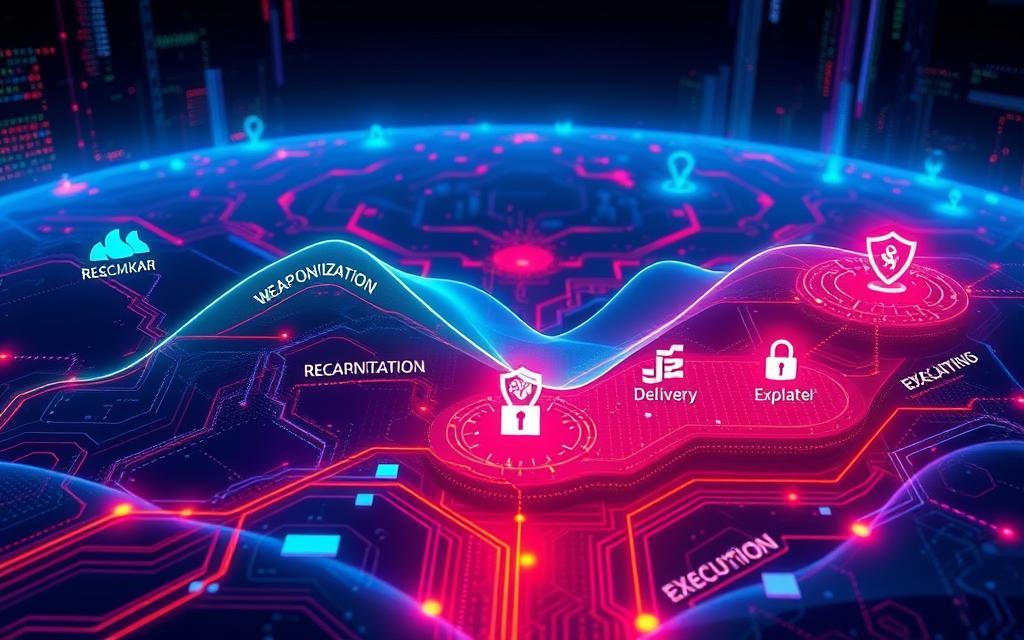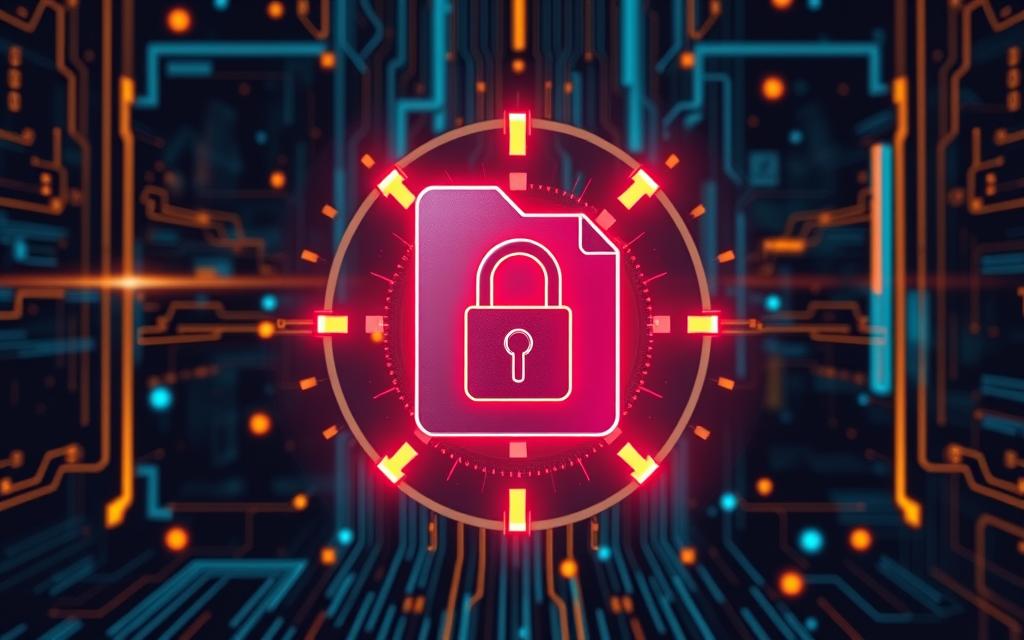I’ve learned how crucial a strong defense in depth strategy is for cybersecurity. This method uses many layers to protect digital assets. It’s key in today’s world where cyber threats are getting more complex. By using a detailed security plan, companies can fight off many threats, like malware and data breaches.
The main idea of defense in depth is simple: if one defense layer fails, others can still stop threats. This strategy helps protect against weaknesses in hardware, software, and human mistakes. By using physical security, network solutions, and managing user identities, companies can build a strong defense against cyber threats.
With more people working remotely and moving to the cloud, the need for layered security has grown. Old security methods don’t work well anymore. Companies need to be more proactive and adaptable to protect their assets. By using defense in depth, businesses can stay ahead of cyber threats and keep their data safe.
Table of Contents
ToggleWhat is Defense in Depth Cybersecurity?
Today, protecting digital assets is more complex than ever. That’s why a strong cybersecurity framework is key. Defense in depth offers a layered security approach that’s becoming more popular.
Defining the Concept of Defense in Depth
Defense in depth means using many security controls to protect digital assets. It’s not just one solution. This strategy adds multiple layers of protection. If one layer fails, others can still stop a threat.
The Importance of a Multi-Layered Approach
Cyber threats are getting more complex. That’s why a defense in depth strategy is vital. It uses a mix of physical, network, and user security to boost resilience against cyber threats.
| Security Control | Description |
|---|---|
| Physical Security | Measures to protect the physical infrastructure, such as access control systems and surveillance cameras. |
| Network Security | Solutions to secure the organization’s network, including firewalls, intrusion detection/prevention systems, and encryption. |
| User Identity and Access Management | Processes and technologies to control and monitor user access to sensitive data and systems. |
Using a multi-layered defense in depth strategy boosts cybersecurity. It lowers the risk of cyber attacks. This approach protects critical data and systems, ensuring business continuity and safeguarding the organization’s reputation and assets.
Challenges of the Modern Threat Landscape
Organizations face many complex challenges in the changing cybersecurity world. The pandemic made more people work from home, making it easier for hackers to attack. Workers using their own devices at home creates new risks that hackers love to use.
Remote Workforce and Cloud Migration
Working from home has changed how we think about security. It’s harder to keep data safe because people use their own Wi-Fi and devices. Cloud migration brings more security worries, like keeping data safe in the cloud.
Increasing Sophistication of Cyber Attacks
Cyber attackers are getting smarter, using new ways to get into systems. They use tricks like phishing to get personal info. Ransomware can really hurt a company by taking data hostage, causing big financial losses.
Dealing with these challenges needs a strong plan that includes good security, teaching employees, and watching for threats. By using a strong defense strategy, companies can stay safe from new threats.
defense in depth cybersecurity
Protecting our digital assets is crucial. A layered security approach is key. This method uses multiple security controls to fight cyber threats.
Defense in depth cybersecurity means adding security layers. If one layer fails, others can stop the threat. This way, organizations can tackle many cyber risks and lower the chance of attacks.
This strategy is not a one-size-fits-all solution. It’s tailored to each organization’s needs. By using physical, network, and user security, companies can boost their cybersecurity.
Key Elements of Defense in Depth Cybersecurity
- Multiple security layers, such as firewalls, intrusion detection systems, and access controls
- Robust identity and access management protocols to ensure only authorized users can access sensitive data
- Comprehensive threat monitoring and incident response capabilities to quickly detect and mitigate potential threats
- Regular security audits and updates to address emerging vulnerabilities and evolving cyber threats
| Security Layer | Description |
|---|---|
| Physical Security | Controls that protect the physical assets, such as buildings, servers, and network infrastructure. |
| Network Security | Solutions that secure the organization’s network, including firewalls, intrusion detection/prevention systems, and virtual private networks (VPNs). |
| User Identity and Access Management | Policies and technologies that manage user identities, authentication, and authorization to access sensitive resources. |
Using a defense in depth cybersecurity approach helps organizations. It builds a strong security strategy. This strategy can handle the changing threat landscape and protect against cyber attacks.
Key Components of a Defense in Depth Strategy
Creating a strong defense in depth strategy means using many layers. These elements work together to make a security plan that can handle new threats. It’s like building a strong wall with many parts.
Physical Security Controls
Keeping the physical place safe is key. Using things like key cards, biometric scanners, and cameras limits who can get in. This makes it harder for unauthorized people to get to important areas and things.
Network Security Solutions
Network security is a big part of a defense strategy. Tools like firewalls, intrusion systems, and VPNs watch and control network traffic. They help fight cyber threats, making sure only the right people and devices can get in.
User Identity and Access Management
Managing who can access things is very important. Tools like single sign-on and multi-factor authentication make sure only the right people get in. This helps protect against data breaches and threats from inside.
By using physical security, network security, and managing access, companies can make a strong defense strategy. This helps them deal with the many threats they face online.
Traditional vs. Modern Defense in Depth Approaches
The way we protect our IT systems has changed over time. Old defense strategies focused on keeping hackers out by using firewalls and antivirus software. But, with the move to digital and cloud computing, we’ve updated our methods.
Now, we use a mix of controls and detection tools to catch and stop threats. This includes things like managing access to sensitive data and using extra security checks to stop hackers from moving around in our systems.
The evolution of cybersecurity strategies can be summarized as follows:
- Traditional defense in depth: Focused on perimeter-based security, with an emphasis on firewalls and antivirus software to protect on-premises infrastructure.
- Modern defense in depth: Incorporates a multilayered approach, including privileged access management, endpoint privilege management, and adaptive multi-factor authentication to secure critical assets in cloud and hybrid environments.
- Evolving cybersecurity strategies: Continuously adapting to address the changing threat landscape and technological advancements, such as the rise of remote work and cloud migration.
| Characteristic | Traditional Defense in Depth | Modern Defense in Depth |
|---|---|---|
| Focus | Perimeter-based security | Multilayered approach |
| Security Measures | Firewalls, antivirus software | Privileged access management, endpoint privilege management, adaptive multi-factor authentication |
| Infrastructure | On-premises | Cloud and hybrid environments |
| Threat Landscape | Traditional threats | Advanced, sophisticated threats |
Implementing Defense in Depth for Cloud Environments
As companies move to the cloud, they must apply defense in depth cybersecurity to this new setting. This means using special security steps for cloud-based apps and data. These steps tackle the unique issues of cloud computing.
Privileged Access Management
Privileged access management (PAM) is key in cloud security. It watches over and secures access to special accounts, both for people and machines. This stops unauthorized access and stops users from getting more power than they should.
By keeping an eye on these special activities, companies can lower the risk of data theft and cyber threats. These threats often come from people with too much access.
Endpoint Privilege Management
Endpoint privilege management (EPM) is also vital for cloud security. It limits what devices can do, like cloud machines and containers. This stops bad actors from moving laterally and fighting off ransomware and malware.
EPM makes sure users and apps only do what they need to do. This means they don’t have too much power, making the whole system safer.
Using these cloud-focused security tools, companies can make their cloud data and apps safer. They create a strong, multi-layered defense against threats. This includes defense in depth cloud security, privileged access management, and endpoint privilege management.
Best Practices for Layered Security
Creating a strong defense in depth means following key security steps. One key idea is the principle of least privilege. This means giving users and systems only what they need to do their jobs. It limits how far an attacker can go if they get in.
Another important step is good patch management and keeping software updated. Regular updates help fix security holes that hackers could use. This keeps your system strong against threats.
- Use the principle of least privilege to limit access and reduce attack impact.
- Have a strong patch management plan to fix vulnerabilities and keep software current.
- Automate software updates to quickly apply security patches.
- Check and update access rights often to remove old or unnecessary permissions.
- Watch for and fix any security issues in your layered security setup.
By following these best practices, organizations can make their security stronger. This helps them stay safe from new threats.
The Role of Automation and AI in Defense in Depth
In the world of cybersecurity, automation and artificial intelligence (AI) are key to better defense strategies. They help protect digital assets from cyber threats. These technologies are very important for keeping data safe.
Automated security tools make security tasks like vulnerability scanning, patch management, and incident response easier. They do these tasks automatically, freeing up security teams to work on bigger challenges. This makes their defense strategies more effective.
AI uses machine learning to detect anomalies, identify potential threats, and respond to cyber incidents quickly. It can look through lots of data, find patterns, and make fast decisions. This helps organizations stop cyber threats right away.
Using automation and AI in their defense in depth plans helps organizations get better at preventing, detecting, and mitigating cyber threats. This makes their cybersecurity stronger overall.
| Automation Capabilities | AI-Powered Capabilities |
|---|---|
|
|
By using automation and AI, organizations can improve their defense in depth strategies. They get the tools they need to stay ahead of cyber threats.

Conclusion
In today’s fast-changing threat world, a strong defense in depth cybersecurity plan is key for companies to keep their digital assets safe. This plan uses physical security, network security, and managing user access to create strong, overlapping defenses. This way, companies can fight off many kinds of cyber threats.
As threats keep changing, it’s important to update defense plans to handle new challenges like remote work and moving to the cloud. Using new tech like automation and AI can also make an organization better at stopping, finding, and dealing with cyber attacks.
By taking a full, multi-layered security approach, companies can make their cybersecurity much stronger. A defense in depth plan is a key part of a strong security setup. It helps lower the risk of cyber attacks and protects an organization’s most important digital assets.
FAQ
What is defense in depth cybersecurity?
Defense in depth is a way to protect digital assets using many security steps. It means if one security measure fails, others can still stop threats.
Why is a multi-layered approach important in cybersecurity?
Today’s cyber threats are complex and sophisticated. A multi-layered cybersecurity approach helps protect against many threats. This strategy uses defense in depth to build strong security.
What are the key challenges posed by the modern threat landscape?
Modern threats include remote work and cloud migration, making it harder to protect against attacks. Cyber attackers use advanced tactics like social engineering and ransomware.
What are the key components of a defense in depth strategy?
A strong defense in depth strategy includes physical security, network security, and managing user access. These layers work together for better cybersecurity.
How has the defense in depth approach evolved over time?
Defense in depth used to focus on on-premises IT. Now, it adapts to digital transformation and cloud computing. It combines preventative controls and detection to stop advanced threats.
What are the key considerations for implementing defense in depth in cloud environments?
For cloud environments, defense in depth needs special security steps. This includes managing access and securing endpoints to handle cloud’s unique challenges.
What are some best practices for layered security?
For layered security, follow the principle of least privilege and keep software updated. Consistently apply these practices to strengthen your security.
How are emerging technologies like automation and AI impacting defense in depth strategies?
Automation and AI are key in improving defense in depth. Automated tools make security easier and AI uses machine learning to spot threats and respond quickly.














